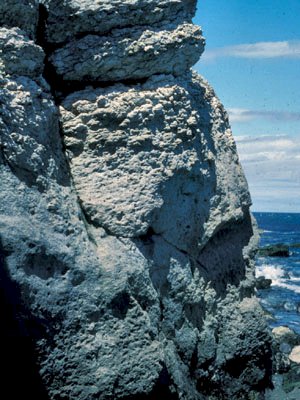Earth Science Conservation Review
| Portmuck, Island Magee | Antrim |
| Site Type: | Coastal section |
| Site Status: | ASSI |
| Council area: | Larne Borough Council |
| Grid Reference: | D458023 |
| Google maps: | 54.84766,-5.73011 |
| Rocks | |
|---|---|
| Rock Age: | Cretaceous, Jurassic (Campanian, Cenomanian, Coniacian, Lower Jurassic, Santonian) |
| Rock Name: | Belfast Marls Member, Cloghfin Sponge Beds Member, Hibernian Greensands Formation, Island Magee Silts Member, Kilcoan Sands Member, Ulster White Limestone Formation, Waterloo Mudstone Formation |
| Rock Type: | Limestone, Marl, Sand, Sandstone |
| Interest | |
| Fossil Groups: | Ammonite, Belemnite, Sponge, Trace fossil |
| Other interest: | Marine sediments |
Summary of site:
The foreshore and cliff section on the north east coast of Island Magee expose a discontinuous sequence of rocks from the earliest Jurassic period, a little over 200 million years ago, to a late stage in the Cretaceous period around 75 million years ago. The special interest of the site lies in the Hibernian Greensands Formation here exhibiting the finest outcrops in Northern Ireland.
The 8 m of Jurassic rocks of the Waterloo Mudstone Formation are seen in the foreshore and have yielded a range of fossils, largely bivalve molluscs and ammonites. The rocks are predominantly soft blue clays separated by thin shelly limestones.
Above the Jurassic and separated from it by an unconformity representing over 100 million years, are the Cretaceous rocks. They form the cliffs west of Portmuck where the Cretaceous Hibernian Greensands Formation, subdivided into three members, can be seen.
The first is the Belfast Marls Member consisting of about a metre of marls and soft sandstones. The Island Magee Siltstone Member follows, 3.5 m thick and containing a mixture of hard and soft glauconitic sands, coloured browny-green by glauconite, a complex mica-like mineral and a clear indicator of marine conditions, and mudstones. The last bed was heavily burrowed by marine invertebrates leaving behind a number of trace fossils. The final unit is the Kilcoan Sand Member, about 5 m thick, consisting mainly of soft green and brown glauconitic sandstones with many trace fossils near the top, mostly feeding burrows.
Above the Hibernian Greensands the Cloghfin Sponge Bed Member appears, about a metre thick, separated from the greensands by an unconformity (a break in the sequence, here probably representing a few million years). The Ulster White Limestone succession then follows with at least 3 members present.
The Hibernian Greensands Formation at Portmuck lacks the Collinwell Sand Member, a unit 9 m thick, present in the Belfast area. This shows the wide variation in local conditions over relatively short distances as the Cretaceous seas invaded the Jurassic land surface.
Fossils are of considerable importance in establishing the age of these rocks, particularly ammonites in the Jurassic. There is a rich collection from the Waterloo Mudstone Formation in the Ulster Museum. Belemnites are the chief zonal fossils of the Ulster White Limestone and have provided the time framework at Portmuck.
The thick and informative Hibernian Greensands Formation provides vital information in defining an axis of deposition in the Cretaceous seas of the time and is an essential component of Northern Ireland's geological history. This is the best and most important sequence and should be protected.
The 8 m of Jurassic rocks of the Waterloo Mudstone Formation are seen in the foreshore and have yielded a range of fossils, largely bivalve molluscs and ammonites. The rocks are predominantly soft blue clays separated by thin shelly limestones.
Above the Jurassic and separated from it by an unconformity representing over 100 million years, are the Cretaceous rocks. They form the cliffs west of Portmuck where the Cretaceous Hibernian Greensands Formation, subdivided into three members, can be seen.
The first is the Belfast Marls Member consisting of about a metre of marls and soft sandstones. The Island Magee Siltstone Member follows, 3.5 m thick and containing a mixture of hard and soft glauconitic sands, coloured browny-green by glauconite, a complex mica-like mineral and a clear indicator of marine conditions, and mudstones. The last bed was heavily burrowed by marine invertebrates leaving behind a number of trace fossils. The final unit is the Kilcoan Sand Member, about 5 m thick, consisting mainly of soft green and brown glauconitic sandstones with many trace fossils near the top, mostly feeding burrows.
Above the Hibernian Greensands the Cloghfin Sponge Bed Member appears, about a metre thick, separated from the greensands by an unconformity (a break in the sequence, here probably representing a few million years). The Ulster White Limestone succession then follows with at least 3 members present.
The Hibernian Greensands Formation at Portmuck lacks the Collinwell Sand Member, a unit 9 m thick, present in the Belfast area. This shows the wide variation in local conditions over relatively short distances as the Cretaceous seas invaded the Jurassic land surface.
Fossils are of considerable importance in establishing the age of these rocks, particularly ammonites in the Jurassic. There is a rich collection from the Waterloo Mudstone Formation in the Ulster Museum. Belemnites are the chief zonal fossils of the Ulster White Limestone and have provided the time framework at Portmuck.
The thick and informative Hibernian Greensands Formation provides vital information in defining an axis of deposition in the Cretaceous seas of the time and is an essential component of Northern Ireland's geological history. This is the best and most important sequence and should be protected.
| Enlander, I., Dempster, M. & Doughty, P., 2025. Portmuck, Island Magee, County Antrim, site summary. [In] Earth Science Conservation Review. https://www.habitas.org.uk/escr/summary.php?item=1215. Accessed on 2025-04-03 |
| Previous Site | Next Site |

